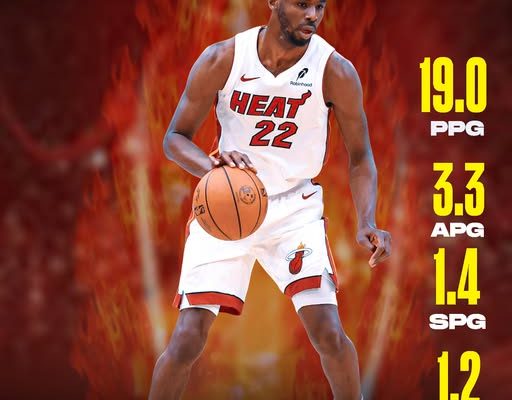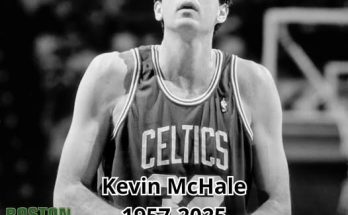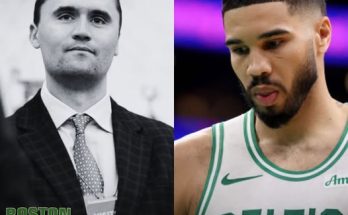Andrew Wiggins in a Miami Heat uniform last season wasn’t just a player adjusting to a new team—it was a full-blown renaissance. The version of Wiggins that arrived in South Beach looked different. Not physically, necessarily—he still had the same slithery athleticism and deceptive strength—but mentally and energetically, he was operating on a different frequency. It wasn’t just about putting the ball in the basket anymore, though the buckets certainly came. What made Wiggins’ season with the Heat such a revelation was how completely he embraced the core tenets of Heat Culture and allowed it to reshape his entire approach to the game. It was no longer about fitting into someone else’s system or finding his rhythm within a predetermined offensive flow. In Miami, he was empowered—and expected—to be a driver, a tone-setter, and a stabilizing force on both ends of the court. And he delivered.
His scoring numbers remained solid, but it was everything else that marked his transformation. For perhaps the first time in his NBA career, Wiggins played with a true sense of purpose that extended beyond the highlight reel. Every possession mattered. Every rotation, every contest, every extra pass. This was Wiggins playing like someone who knew he had something to prove—and more importantly, someone who knew exactly how to prove it. In many ways, the Miami Heat served as the perfect laboratory for his evolution. The franchise has a well-earned reputation for squeezing the best out of players, particularly those who arrive with elite physical tools but inconsistent production. For Wiggins, it was the structure and accountability he had always needed but rarely received in full measure. In Golden State, he learned how to win. In Miami, he learned how to lead.
There was a marked uptick in his defensive engagement from the moment he put on that Heat uniform. No longer was he the occasionally aloof on-ball defender who relied on raw ability to disrupt plays. In Miami, Wiggins was locked in. He took on the challenge of guarding the opposing team’s best wing player night after night and embraced it with a quiet, lethal intensity. His defensive metrics were among the best of his career—he posted career-high averages in both steals and blocks, but that only told part of the story. His ability to blow up dribble handoffs, slide over in help coverage, and rotate with urgency turned him into a legitimate defensive anchor on the wing. He wasn’t just making plays—he was preventing them before they even had a chance to develop. In one memorable stretch of games, he hounded Jayson Tatum, Paul George, and Brandon Ingram into a collective shooting percentage under 38%. It was a masterclass in disciplined, physical, intelligent perimeter defense.
But his impact wasn’t just confined to defense. Offensively, he took on more ball-handling responsibilities than ever before in his career. It wasn’t uncommon to see Wiggins initiating half-court sets, especially when Jimmy Butler sat or when the Heat needed to give Tyler Herro space to work off the ball. His passing took a noticeable leap forward. Not just in terms of assist totals—which did hit a career-high—but in terms of decision-making. He played with more patience, read defenses more effectively, and displayed a surprising level of creativity in finding cutters or bigs in the dunker spot. He wasn’t just a scorer anymore; he was a creator. Whether it was a quick read out of a double-team or a cross-court skip pass to the corner, Wiggins showed that he could be more than a cog in the machine. He could operate as the engine itself.
Perhaps what made Wiggins’ transformation most impressive was the consistency with which he sustained it throughout the season. This wasn’t a flash-in-the-pan hot streak or a month of elite basketball followed by weeks of anonymity. This was sustained, reliable excellence. There was a steadiness to his game that fans and critics alike had rarely seen from him in prior years. He didn’t disappear in fourth quarters. He didn’t shy away from the moment. He made the big defensive stops, hit crucial free throws, and took—and made—important shots down the stretch. For a player who had spent much of his early career being tagged with the “inconsistent” label, his Miami stint was a powerful rebuttal.
There were also cultural intangibles at play that elevated his game. The Heat’s veteran core, led by Jimmy Butler, Kyle Lowry, and Bam Adebayo, provided Wiggins with the type of locker room leadership that fostered accountability and high standards. But more than just being around veterans, it was clear that Wiggins was respected as a key contributor in his own right. The Heat coaching staff, led by Erik Spoelstra, empowered him to take ownership of the team’s success. Spoelstra designed sets that played to Wiggins’ strengths—quick post-ups against mismatches, weakside isolation actions, transition opportunities off steals—and pushed him to grow in areas that had previously been underdeveloped. That included more dynamic pick-and-roll creation, tighter footwork, and refined mid-range decision-making.
Wiggins thrived under that structure. He played freer, but also smarter. The mental lapses that once plagued his game—lazy closeouts, poorly timed fouls, unnecessary isolation possessions—became increasingly rare. In their place came calculated risks, timely contests, and smart, unselfish ball movement. It was almost as if he had internalized the Heat’s ethos and recalibrated his basketball instincts around it. This wasn’t just statistical growth; it was philosophical alignment.
Off the court, Wiggins seemed more at peace than he’d ever been. The South Florida lifestyle agreed with him, but more importantly, he seemed to have found a home that valued what he brought to the table—not just as a player, but as a person. There was a visible joy in the way he interacted with teammates, took part in film sessions, and engaged with the Miami community. That sense of belonging translated directly onto the court, where his confidence was as palpable as his production. You could see it in the way he played—assertive, aggressive, and unbothered by the weight of expectation. He was no longer trying to prove that he deserved to be a No. 1 overall pick. He was simply proving that he belonged at the highest level of competition, in the highest-stakes moments, alongside the game’s elite.
That became most apparent in the playoffs, where Wiggins’ role grew even more pronounced. With Butler battling through injuries and Herro drawing heavy defensive attention, Wiggins became a go-to option in clutch situations. His ability to create off the dribble, attack mismatches, and defend across three positions made him invaluable in a series of hard-fought battles against the East’s top contenders. In a thrilling seven-game semifinal series against the Celtics, Wiggins averaged 22 points, 6 rebounds, 4 assists, and nearly 2 blocks per game, all while defending Jaylen Brown and Jayson Tatum in alternating stints. His fingerprints were on every part of the game, every possession, every momentum swing. The Heat ultimately fell short of the Finals, but Wiggins left the postseason with his reputation soaring higher than it had been at any other point in his career.
That version of Andrew Wiggins—a player willing to defend, pass, hustle, sacrifice, and lead—was a far cry from the one who entered the league as a highly touted but inconsistent scorer. It was the culmination of years of experience, lessons learned through adversity, and finally being placed in the right system with the right expectations. Miami didn’t just tap into Wiggins’ potential—they helped him fully realize it. And once it clicked, there was no turning back. What made his Miami stint so special wasn’t just that he played the best basketball of his life—it was that he did it in a way that felt sustainable, replicable, and deeply impactful.
Looking ahead, the question now becomes not whether Wiggins can replicate that performance, but whether he can continue to evolve. If Miami chooses to re-sign him or extend their commitment to him long-term, they’ll be doing so with the confidence that they’ve unearthed a true foundational piece—a versatile two-way wing who can anchor defensive schemes, ignite transition opportunities, facilitate offense, and close games. And if another team attempts to lure him away, they’ll be paying a premium for a player who has finally merged his tantalizing upside with a grounded, veteran-level approach to the game.
In retrospect, Andrew Wiggins in a Miami Heat uniform wasn’t just a great fit. It was a transformation. A redemption arc. A narrative rewrite. He arrived as a former All-Star seeking renewed purpose and left as a proven, trusted contributor with championship pedigree and the type of adaptable skill set that every modern NBA contender covets. In the ever-evolving landscape of the NBA, where roles shift and identities are constantly being reshaped, Wiggins found clarity. He became more than just a piece. He became essential. And in Miami, essential players tend to leave legacies.



